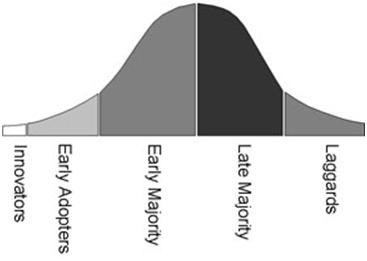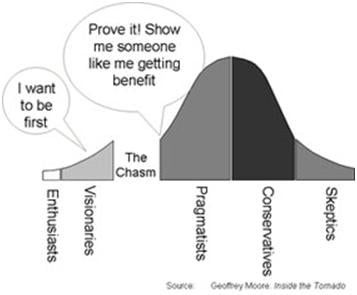This blog regularly talks about the concept of the buyer's journey and how important it is to generate content that speaks to your buyer in a language they can relate to and is relevant to them at that particular point in their buying journey. But now here is a somewhat different twist. Figuring out to whom you wish to sell, and what strategy you should adopt when going to market is an important part of a firm's marketing planning and relies heavily on understanding your buyers IN RELATION TO THE MATURITY OF THE MARKET.
The technology adoption lifecycle has become the key theoretical model for explaining and determining how your marketing plan and go to market strategy should change based on buyer maturity. MathMarketing's Hugh MacFarlane writes about this in his complementary Funnel Vision series of articles, featured on our Resources page to subscribe or go to MathMarketing for the specific article, although the essence of the article is reproduced below.
In 1957, the 'technology adoption lifecycle' model emerged as a way of explaining buyer maturity (Iowa State College used it to track farmers' purchasing patterns for hybrid seed corn). Six years later, academic Everett Rogers broadened and popularised the concept in his book Diffusion of Innovations. Even if Rogers does not ring a bell, you are probably familiar with elements of his thesis. The term 'early adopter', for instance, is used frequently today in management talk, as is the expression 'laggard' (those who buy well after everyone else).

Geoffrey Moore brought the concept back to life in 1991 in his bestseller Crossing the Chasm, and again in 1995 with the even more successful book Inside the Tornado. Moore points out that the adoption model is one for describing buyers, not products. The question is not 'where is my product on the curve?' but 'where are my buyers on the curve?' Why is this important? Because the strategy that is right for early adopters is completely inappropriate for pragmatists. So you had better know your buyers.
Enthusiasts and visionaries who quickly adopt new technologies are seeking a strategic advantage. They are happy to team with you to turn your unproven technology into a complete solution, provided they can be among the first to test it. The pragmatists, on the other hand, want to see some evidence that this new technology works.

Therefore, the right strategy in a new market is to find the visionaries. It is all right to offer them an incomplete solution provided you offer lots of services to help overcome any early deficiencies. The 'chasm' to which Moore refers is that horrible waiting period when the early adopters have done their thing, but the pragmatists are not yet convinced that the product is safe to buy. With pragmatists, you need to target a very narrow group so they can take comfort from seeing other similar businesses adopt and profit.
Your strategy flip-flops on many fronts. It will change from:
- direct to indirect and back to direct again
- broad to ultra-narrow, to broad (and then look for niche add-ons)
- value pricing, to market pricing, to aggressive price leadership.
With this model in mind, here are some practical steps to help make your bets right.
- Make a list of the product markets you have chosen to enter.
- Use the collective wisdom of your team to determine how mature most of the buyers are for each of these product markets.
- Select the strategy that matches this stage of buyer maturity.
Above all, set your strategy with confidence, and don't get lost in the chasm.
